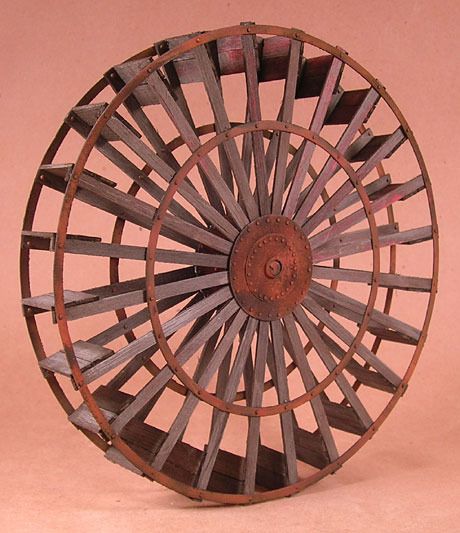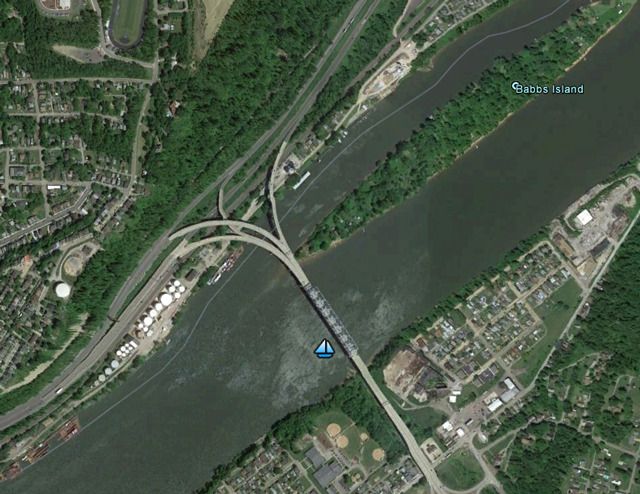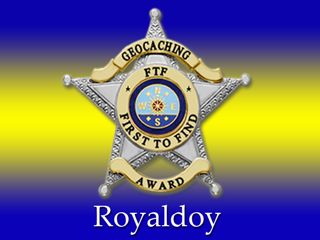Winchester Loot Mystery Cache
SonicSculptor: Can’t beat the muggles on this one. Thanks to all those that visited.
-
Difficulty:
-

-
Terrain:
-

Size:  (regular)
(regular)
Related Web Page
Please note Use of geocaching.com services is subject to the terms and conditions
in our disclaimer.
Site along the Ohio River, where in 1866, the luxury riverboat Winchester made history .
A Safe, reportedly full of gold, cash, jewels, & jewelry was onboard and never recovered! Can you find it? Maybe today is the day? READ the Full story below & DECODE the coordinates.
Park officials are aware of the cache. At times, MANY Muggles. Some stealth maybe required.
Cache ONLY available Dawn to Dusk!
Check your solution 
'The mighty side-wheel packet, "Winchester," largest and most lavish ever to ply the Ohio River in the Pittsburgh to Parkersburg trade, was upbound just off East Liverpool on a cold February night in 1866 on the return leg of her maiden voyage.
William J. Abrams, the pilot on watch, noted it was just after 3:300 in the morning on that February 23rd when he passed the sleeping town (East Liverpool, OH) off his port bow. He kept a particularly close watch from the darkened pilot house because the current was running swiftly in the swollen stream and chunks of floating ice occasionally bumped against the sides.
He strained his eyes in the gloom as he neared the approach to Babb's Island. He knew he had to keep the island to port and close to the West Virginia shore to keep safely within the channel. As A. Shepherd, the master, was asleep, as were the passengers in the big craft's 54 staterooms.
The boat bulked while against the gloom of the river. Her new paint gleamed and her brasswork was spotless. The big paddle wheels, each 28 feet in diameter turned steadily as they drove the "Winchester" toward her home port of Pittsburgh.
Since she was a brand new craft and termed "the finest ever put in service in the Pittsburgh-Parkersburg trace," she carried a nearly-full passenger list. Her hold, more than six feet in depth, was packed with cargo. On the forward deck, she carried more cargo, including bales of hay and straw.
The shades were drawn in the stateroom windows to prevent a flickering light from reflecting on the water and confusing the pilot. The pilot depended on his carefully catalogues memories of the river as she appeared in all stages and at all seasons. Salient landmarks stood out through the gloom. He steered the craft with the confidence of a man walking through his darkened livingroom - knowing were all the danger spots were and how to work his way up to the open channel. The East Liverpool wharf was a frequent stop for the packets.
Her (Winchester) cabin was 165 feet long. Its chandeliers were fabricated in Philadelphia, as were the sheets and pillowcases on her berths. The silverware had been purchased in New York City. The owners, striving for innovations in the river boat tradition of dining in the grand manner, had equipped the galley with a newfangled steam table to help keep the food warm.
She carried a Chickering piano in her main salon. George Young, the bar-keeper, served drinks to the swells and nabobs and just common folk who traveled on the "Winchester." James Diven was the steward.
Frederick Way Junior of Sewickley, the region's best-known river historian, commented that she was lavishly furnished, probably the best that ever ran in the trade. Her sidewheel engines, built by James Rees & Sons of Pittsburg, were 22 inches in diameter with a seven foot stroke.

*** Captain Moore still had not sighted the foot of Babb's Island when the dreaded cry: "Fire! Fire!" carried upward from one of the lower decks.
The deckhands on watch hurried toward the hand pumps, but the flames spread quickly to oil barrels amidships. In an emergency such as this, Captain Abrams knew there was only one hope-beach the craft's bow against the nearest shoreline in hopes the crew and passengers would be able to leap to safety.
Passengers, roused from their staterooms by the clamor, ran wildly about the deck in their night clothing. Captain Abrams swung the bow toward the West Virginia shore and the bells in the engine room clanged as he rang directions to the men on watch below.
The boat was"blazing like tinder' as she swept toward shore. But fate intervened. The bow grounded on a submerged sandbar and the boat came short of touching shore. Many of the passengers had fled aft to put as much distance as possible between themselves and the flames. The stern, caught by the strong current, swung toward the center of the stream.
The roaring blaze amidships made it impossible for many of the passengers to make their way to the bow and leap toward the shore. With the flames between them and safety, many of the terrified passengers leaped overboard and attempted to swim. Some who jumped from the upstream side were swept underneath the hull and drowned. Others lost their lives in a vain attempt to swim in the icy waters. And some burned to death.
W. M. Sheets, a passenger who was an expert swimmer, dragged an hysterical woman from a cabin thinking she was his wife and swam to shore with her in tow. But when he reached the ice fringed bank, he found it was a woman he did not know. A later search showed that his wife and the husband of the woman he had saved had both burned to death.
A man who went down in history only as "Racky" Porter of New Cumberland leaped into the river and swam with his small son on his back. A river historian found the son still living in New Cumberland in 1890, but did not record his name.
The flames were visible for great distances. East Liverpool roused itself for rescue attempts, but when the first samaritans arrived on the scene it was too late for anything except to aid the survivors. Mrs. Enoch Bradshaw looked out a window of her big home on East 4th Street at Broadway present sit of the Carnegie Library and saw the flames outlined starkly against the dark West Virginia hills.
When dawn came, the proud "Winchester" was burned to the water line. Estimates of the loss of life ranged from 20 to 30 or more. In addition to the passen- gers, about eight deckhands and roustabouts were drowned or burned to death.
Legend and tradition say they were buried on the spot in unmarked graves. And if they were, their mouldering bones are deep under the river now. The level has been raised twice in the interim by the artificial pools created by dams. When the "Winchester" went down, the first series of locks and dams was 40 years in the future.
In her era, the river was navigable when mother nature provided enough water for the shallow draft boats. But in times of drought in late summer and early fall, steamboats were sometimes tied up, idle. Shipping interests had started a campaign for locks and dams to assure their boats "Nine Feet to Cairo" a safe channel in all seasons. The river's pool off Chester and East Liverpool was raised again in the 1960's with the completion of the Stratton "super dam."
Despite intensive research, there's no indication just how many passengers the "Winchester" carried on the fateful night. Frederick Way says there is no exact photo of the "Winchester" and "not even a sketch" so far as he can learn. "She was brand new' she was lost before any photos were taken," he says.
Tradition and legend says that the purser's safe was lost in the icy depths of the Ohio that night and never has been recovered.
The Pittsburgh Post's account said that the captain's report to U. S. inspectors "showed the boat and her car- go to be of immense value. A large sum of money in the purser's safe was lost."
McCord's history says that the craft "had a large list of passengers besides Heavy consignments of freight." H.B. Barth, curator of the East Liverpool Historical Society, confirmed the Report that the "Winchester" safe was never recovered.
Ernest C. Smith of West 3rd Street, a student of river lore who built models and painted river scenes, said he had heard similar stories from old-time steamboat men. Barth Wrote the story of the disaster in 1924 in his "History of Columbiana County." Barth said the "Winchester" was beached on the bar near Chester, off shore from The site that later held the plant of the American Sheet & Tin Plate Company. Smith said he had heard legends that the passenger list "included a lot of rich Plantation owners from the South on a pleasure cruise to Pittsburgh, and they Had stowed all their jewels and other valuables in the purser's safe."
Smith continued, "Whatever was in that safe, it's probably under many feet of river muck now." Barth added, "The changes in the channel and the river pool, along with many floods, probably buried the safe to the point that it never will be found." Both men speculated that perhaps when excavations were to made on the new Chester Bridge(1897-1969), something would turn up. Nothing did, of course.
*** This is an edited account of the 1866 disaster, the burning of the "Winchester", off the shores of Chester and Babb's Island. The article was originally titled FIRE ON THE RIVER and was written and information accumulated by the late Robert Popp, the esteemed East Liverpool Review reporter.
****************************************************************
COORDINATES:
N40 36.ABC
W80 33.XYZ
A= 1st Digit of the year PLUS the last Digit of the year of the disaster
B= 1st digit in the "number of Staterooms" onboard the Winchester
C= 2nd Digit of the "paddle wheel diameter" MINUS(-) the 1st Digit
X= 2nd digit of her (Winchester) "Cabin Lenth" PLUS Three(+3)
Y= Lenth of the "engine's stroke" MINUS Two(-2)
Z= 3rd digit of the "YEAR Barth wrote the story of the disaster" MINUS One(-1)
Check your solution

*****************************************************
Congrats to Royal Doy on the FTF! 
Additional Hints
(Decrypt)
chyy hc tragyl juvyr fcvaavat onpx & sbegu